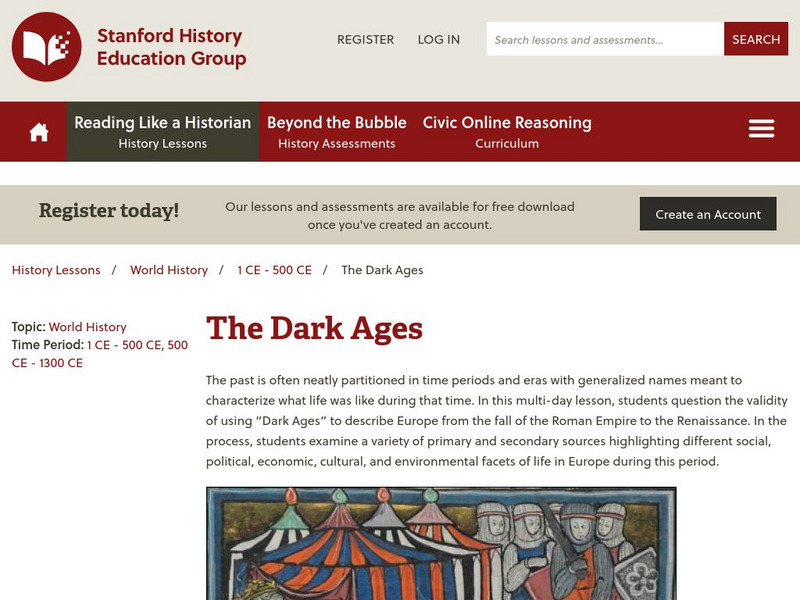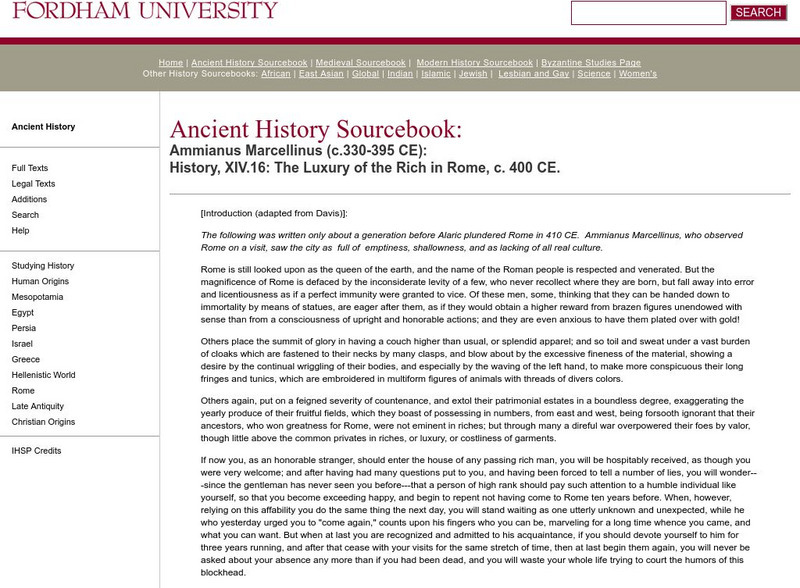Hi, what do you want to do?
Khan Academy
Khan Academy: Portrait of Vespasian
This naturalistic portrait of the emperor Vespasian (reigned 69-79 C.E.) clearly shows the lined complexion of this battle-hardened emperor, and also the curious 'strained expression' which the Roman writer Suetonius said he had at all...
Academy of American Poets
Poets.org: W. H. Auden
This Academy of American Poets webpage provides, in addition to a short overview of his life, a selected bibliography as well as hyperlinks to a number of Auden's poems such as "On the Circuit" (read by the author), "Lullaby," and "The...
Ducksters
Ducksters: History of Ancient Rome for Kids: The Roman Emperors
Kids learn about the emperors of Ancient Rome on this site. After the fall of the Roman Republic, these powerful leaders ruled much of the known world.
Stanford University
Stanford History Education Group: The Dark Ages
[Free Registration/Login Required] Primary and secondary source documents, timeline, PowerPoint, and lesson plan reinforcing life during the Dark Ages in Europe. Over several days students will come to understand all aspects of this...
Stephen Byrne
History for Kids: Alaric the Visigoth
History for Kids presents overview of the Visigoth leader, Alaric I, who rose to prominence in the Roman Army and is responsible for the sack of Rome. Teacher resources included.
Then Again
Then Again: Web Chron: The Beginnings of German Christianity 500 1000.
While conventionally the period after the fall of the Roman Empire in the West is thought of as an age of darkness, in fact it was the formative period of a new culture. Christian missionaries brought a form of Christianity to the...
Internet History Sourcebooks Project
Fordham University: Ancient History Sourcebook: Ammianus Marcellinus (C.330 395 Ce)
Fordham University provides translation of a commentary by the Greek historian Ammianus Marcellinus that criticizes everything about the 4th century Roman life, from overeating to bad driving.
Other
Armenian History
A very comprehensive look at Armenian history written by an Armenian so expect some partiality. Use the table of contents to navigate the site. Pictures illustrate every section and a glossary is included.
Then Again
Then Again: Web Chron: Western and Central Europe Chronology: The Ostrogoths
This brief article details the rise and fall of the Ostrogoths, a Germanic tribe of the fifth and sixth centuries.
CommonLit
Common Lit: Excerpt From "The Odyssey: The Sirens" by Homer
"The Odyssey" is an epic poem about a Greek hero named Odysseus, also known as Ulysses in Roman myths, and his 10-year journey home after the fall of Troy. In this excerpt, Ulysses encounters the Sirens while at sea. A specific purpose...
A&E Television
History.com: Tailgating: How the Pre Game Tradition Can Be Traced to Ancient Times
The ritual grew as ownership of automobiles and then mass production of portable grills and plastic coolers soared. Tailgating before college and professional football games is an American tradition. Temporary tent cities pop up in...
Countries and Their Cultures
Countries and Their Cultures: Palestinians
Palestinians inhabit an area east of the Mediterranean Sea and south of Lebanon. The Jordan River, Lakes Huleh and Tiberias, and the Dead Sea separate Palestine from Jordan. Christians refer to Palestine as "the Holy Land." Today...
Khan Academy
Khan Academy: World History: 600 Bce 600 Ce Second Wave Civilizations
We have 2 resources from here but should be cross-checked against embedded videos.
Other
Si Spain: Auge Y Caida Del Imperio Espanol
This resource provides the chronology of the rise and fall of the Spanish Empire.
Curated OER
Educational Technology Clearinghouse: Maps Etc: Italy, Ad 525
A map of Italy at the time of Ostrogoth rule under Theodoric the Great (AD 454-526) after the fall of the Western Roman Empire. This map shows the extent of the Kingdom of the Ostrogoths, Kingdom of the Vandals (Corsica and Sardinia),...
Curated OER
Educational Technology Clearinghouse: Clip Art Etc: Edward Gibbon
Edward Gibbon (April 27, 1737 - January 16, 1794) was an English historian and Member of Parliament. His most important work, The History of the Decline and Fall of the Roman Empire, was published in six volumes between 1776 and 1788.
Curated OER
Educational Technology Clearinghouse: Clip Art Etc: Puteal
Puteal, properly means the enclosure surrounding the opening of a well, to protect persons from falling into it. It was either round or square, and seems usually to have been of the height of three or four feet from the ground. It was...
Other popular searches
- Fall of the Roman Empire
- Fall of Roman Empire
- The Fall of Rome
- Fall of Rome Activity
- The Fall of the Roman Empire
- Fall of Rome Chart
- Fall of Roman Republic
- History Fall of Rome
- Fall of Rome America
- The Fall of Rome Empire
- Barbarians Fall of Rome
- Fall of Rome Empire















